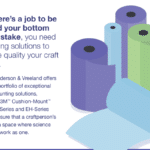Order, Store, Use, Repeat
Customers call every day to order stickyback, plate materials, cleaning solvents, software, equipment, and more. Even though they monitor usage on spreadsheets and assorted lists, there is always something that’s critical to an upcoming job. So we ship it out and they run the job. Keeping customers fully supplied is what we do and we’re very good at it, even in these uncertain times. But with every order I think of how there are always ways to do things just a little better. It all comes down to inventory management.
Order, store, use, repeat is the mantra of inventory management: Order what you’re going to need, store it until you need it, use it up, and repeat the process. It seems simple, but in a busy shop with a week-in and week-out mix of long run and short run jobs, keeping track of materials and supplies can be an ongoing challenge.
JIT and MRP
Most businesses use a mix of JIT (Just-In-Time) and MRP (Material Requirements Planning) to ensure essential materials are readily available. For instance, daily-use things like stickyback and plate materials usually fall into the MRP bucket, while rolls of a substrate that’s used four times a year are probably handled using a JIT process. However, the daily rush of business and dozens of orders means many shops may not always have the most accurate sense of what is really in the warehouse or around the fringes of the press room. To keep a handle on inventory levels, some shops rely on spreadsheets. In others, the production manager or press operator gets a call to make sure 42,000 feet of a certain clear label stock is on hand so it can be printed and shipped out. But despite what the spreadsheet shows, there are only 3,200 feet of that material left and a delivery can’t happen for five days, maybe six. Which means the job may go someplace else. Maybe some additional requirements planning would have made the difference.
A Sense of Where You Are
One of the things I do when visiting customers is try to get a sense of the jobs they are doing and what is in the plan for the next week or so. I do this in the context of other jobs they have been running and encourage them to help make sure they have enough materials in stock so they can make a play for jobs, even if they don’t have all the materials they need. In the case of the clear label stock maybe I would have encouraged them to have made sure there were, say, 15,000 to 20,000 feet on hand so they could deliver at least a portion of a new job in a couple of days while placing an order for another 30,000 feet of substrate, and run the rest of the job in about a week. It might have kept the work in house.
The same goes for all the supplies a shop may use (rolls, sleeves, ink, plate material, and so on). I encourage customers to keep a running tally of everything they use—before and after each job—and I do the same thing on every visit. This lets me provide a back-up of a shop’s inventory so I can note, for example, that they normally use 20 rolls of a certain material each month but a big job trimmed the supply to just five rolls with two weeks of month left. It’s easy for the difference to get past the inventory person but knowing about it and placing an order may avoid coming up short at 9:15 on a Friday night for a job scheduled to ship on Monday afternoon.
The Right Mix for Your Shop
There are multiple ways to keep track of all the supplies you use and adopt a mix of JIT and MRP that’s right for your company. This is a place where you have to be proactive, perhaps by setting minimum and maximum supply levels. Some shops I know have a person whose job entails ensuring supply levels are maintained within those levels. They work with the production teams to track quantities of all materials used, helping reduce the chance of surprises. One other thing, and this is easily forgotten: be sure to adjust inventory levels when a customer goes away or when new ones come on board.
It all comes back to order-store-use to help ensure you can say ‘yes’ when a customer needs something done right away. And of course, contact us at Anderson & Vreeland or call us at 866.282.7697 for help in building the right order-store-use strategy for your business. We stock and can deliver much of what you use on a regular basis to help ensure you have what you need.
 By Rebecca Schobel
By Rebecca Schobel
Account Manager
Southern California & Las Vegas
Anderson & Vreeland Inc.
rschobel@andvre.com




